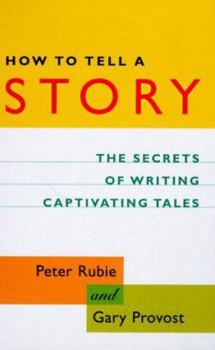How to Tell a Story: The Secrets of Writing Captivating Tales
kThe renowned Gary Provost and his colleague Peter Rubie show readers how to transform their fiction, non-fiction or screenplay idea into a tale sure to find an audience. This description may be from another edition of this product.
Format:Hardcover
Language:English
ISBN:0898798094
ISBN13:9780898798098
Release Date:January 1998
Publisher:Writer's Digest Books
Length:234 Pages
Weight:1.14 lbs.
Dimensions:0.9" x 6.2" x 9.3"
Customer Reviews
5 ratings
A book we all should read
Published by Thriftbooks.com User , 16 years ago
Every once in a long while I will find a book that does not fall into my two criteria for books the first always is "Was it a good book" and the second is mostly always was I entertained did I have fun while reading it or did I just slog through it because I felt I had too? This book actually managed to fulfill both requirements I was entertained and it was a good book and it also added a third dimension could I write a book? I have always wanted to write a book but like many others I have always been stopped by some very simple questions; how would I go about writing a book and who in world would read such a book if I ever wrote it. I'm sure many of you aspiring authors have struggled with just this very aspect of literature. The core at the center of this book is that even though you may not talent or ability as a writer you can always come up with a good idea and even if you never manage to write a story that other people want to read maybe you can write a story that you always wanted to read. Overall-I will not lie I have a bare minimum of talent especially in the ability of proofreading but for those of you who could be great authors or think you could be this book is a great resource.
Best I've Read
Published by Thriftbooks.com User , 19 years ago
This is one of the best books I have ever read on how to tell (or write) a story and I've read about 50. This book is simple and basic and therein is its beauty. In simple terms and a basic straightforward style, Rubie covers all the subtle and enthralling techniques and characteristics of writing gripping, captivating, page-turning tales. Only a true master can make the subtle so simple. I don't just recommend you read this, I recommend you read and read again. A great investment for any writer and really a great read for anyone.
Gold in them there hills!
Published by Thriftbooks.com User , 20 years ago
Rubie's book is great.I got a copy because I thought it'd be fun to write something out of my usual genre. (Search on author "Stephen L. Nelson" if you want to see what I've written.) And I was really well-rewarded for my reading investment...As an author, there are some things I know about and so get to "double-check" on Rubie's notions and conclusion. In the handful of places where I, as an oft-published author of nonfiction, can test his knowledge, he's absolutely right. Which then leads me to conclude, "Hey, Rubie's probably right about all this other stuff, too."The one other thing I will say about this book--and this isn't a criticism of the book but more advice for readers--is this: some of the stuff that Rubie talks about is a little subtle. If one isn't careful in one's reading, one might miss some pretty important stuff. I think you'd want to read this title more than once...
A toolbox for expression
Published by Thriftbooks.com User , 22 years ago
Writers live in a world where the right tools and skills can make the difference between surviving in a hovel and living in a comfortable home. 'How to Tell a Story" is a book that brings many of these skills and tools together in a useful format. Like a painter looking for just the right brush and stoke, I used the ideas and guidelines presented to help finalize my own book, which I'm happy to say is now being published (with minimum 'editing'). Highly recommended.
An insightful, hands-on book that solves immediate problems
Published by Thriftbooks.com User , 25 years ago
This book by Peter Rubie and the late Gary Provost is filled with the kind of hands-on advice you'd get from very good writing instructors. More clearly than in many other books, Rubie and Provost explore the nature of character, objectives, and obstacles, and demonstrate that plot and structure derive from character and conflict. While the book is primarily intended for writers of fiction and nonfiction narrative, the principles can also be used by screenwriters and playwrights, and in fact most of the authors' examples are taken from films.I'm a playwright and read this book while blocked on a project. Thanks to the ideas expressed here, I was able to go back and immediately think of further ideas and a "next step." The only reason I didn't rate the book 5 stars is that I think you can quarrel with some specific pieces of advice and with some analyses (e.g., the authors cite the play and movie "Betrayal" as an example of flashback, while I think it's actually an example of a nonlinear time sequence). (Also, it's surprising that a book about writing consistently misuses the word "it's.") But those are quibbles. I found this to be a useful, thorough book.






